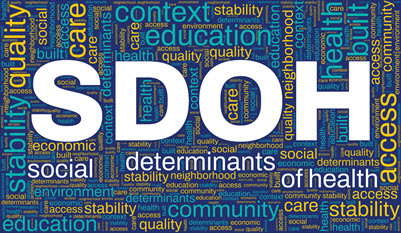And discover which codes are now unbillable parent codes.
What happens outside a patient’s point of care can have a significant impact on their overall health and well-being. And thanks to the latest ICD-10-CM code update, when your eye care provider discovers conditions that require or affect a patient’s management or treatment — social determinants of health (SDoH), financial abuse, maltreatment, neglect — they have 42 new ICD-10-CM codes they can include in the medical record as of April 1, 2023.
Here is your first look at the new codes, along with some expert analysis to help you add them to your coding arsenal.

Examine Chapter 19 Code Additions
ICD-10-CM Chapter 19: Injury, Poisoning, and Certain Other Consequences of External Causes (S00-T88) offers 12 new codes that relate to confirmed or suspected financial abuse. What’s particularly helpful about these new codes is they allow specification about whether the subject of the abuse is an adult or child, and distinguish between initial and subsequent visits, as well as sequela.
The new codes are as follows:
o T74.A1- (Adult financial abuse, confirmed)
o T74.A2- (Child financial abuse, confirmed)
o T76.A1- (Adult financial abuse, suspected)
o T76.A2- (Child financial abuse, suspected)
Initial, subsequent, sequela: Like most of the Chapter 19 code categories, you’ll assign 7th characters: A for the initial encounter, D for subsequent encounters, and S for an encounter to evaluate sequala resulting from the condition. Remember to use an X place marker in the 6th character position to build the full code.
Other helpful additions involve inclusion terms for T74.3 (Psychological abuse, confirmed) and T76.3 (Psychological abuse, suspected), which provide a way to accurately document patients who are the target of confirmed or suspected harm, physical violence, or sexual abuse.
See What’s Been Added to Chapter 20
ICD-10-CM Chapter 20: External Causes of Morbidity (V00-Y99) provides 15 new codes that relate to maltreatment and neglect. Now, you’ll be able to code the perpetrator with greater specificity, using an expanded code set for Y07.0- (Spouse or partner, perpetrator of maltreatment and neglect).
This means the codes you’ve previously used to indicate the perpetrator of abuse will soon be unbillable parent codes. For example, Y07.01 (Husband, perpetrator of maltreatment and neglect) is broken down into Y07.010 (Husband, current …) and Y07.011 (Husband, former …). ICD-10-CM has structured the other codes the same way, allowing you to specify the perpetrator of abuse as being the current or former wife, male partner, female partner, or nonbinary partner.
The addition of four other codes will allow you to identify maltreatment coming from other family members:
Each of these four codes also list relationship details as inclusion terms, making it easy for you to assign the correct code. For example, under Y07.44, ICD-10-CM defines “child” as being any of the following: adopted, biological, daughter, son, foster, in-law, nonbinary, or stepchild. Lastly, you can also document whether the maltreatment or neglect originates with a friend or acquaintance of the patient with the addition of Y07.54 (Acquaintance or friend …).
Explore the Chapter 21 Code Expansion
The remaining 15 new codes are related to SDoH and can be found in ICD-10-CM Chapter 21: Factors Influencing Health Status and Contact with Health Services (Z00-Z99). These new codes address patient problems related to education and literacy (Z55-), physical environment (Z58-), housing and economic circumstance (Z59-), personal history of abuse in childhood (Z62.81-), and patient noncompliance (Z91.1-).
“Potential risk adjustment based on SDoH means related new and revised ICD-10-CM codes could have an impact beyond just capturing patient data in the medical record,” notes Kent Moore, senior strategist for physician payment at the American Academy of Family Physicians. Because of this, it’s therefore increasingly important to pay attention to these details when coding.
Z55-: You’ll find Z55.6 (Problems related to health literacy) added to the code set, which applies to situations when the patient has difficulty understanding their health information or instructions or has problems completing the forms, per its inclusion terms.
Z58-: ICD-10-CM has added new codes related to problems concerning the physical environment. Those include parent code Z58.8- (Other problems related to physical environment) and billable code Z58.81 (Basic services unavailable in physical environment), which refers to lack of internet, telephone, or utilities due to them being geographically unavailable, or an otherwise inadequate environment. Code Z58.89 (Other problems related to physical environment) is also available for use.
Z59-: Four new codes cover inadequate housing, which allow you to report more specific debilitating economic circumstances. Until these recent changes, lack of heat, restriction of space, technical defects, and unsatisfactory surroundings all fell under Z59.1 (Inadequate housing). ICD-10-CM deleted those inclusion terms for that code and added the following:

The ICD-10-CM update includes synonyms under Z59.12 to denote lack of electricity, gas, oil, and water services, as well as pest infestation, restriction of space, technical defects, and unsatisfactory surroundings for Z59.19.
Also note the newly expanded descriptor for Z59.87 (Material hardship due to limited financial resources, not elsewhere classified) and revisions to its inclusion terms, which tell you to use the code specifically when the patient is unable to obtain such material necessities as childcare, clothing, utilities, and other basic needs.
Z62.8-: There are two new codes under the parent code Z62.81- (Personal history of abuse in childhood). One is Z62.814 (Personal history of child financial abuse), and the other is Z62.815 (Personal history of intimate partner abuse in childhood). These codes come with Excludes notes which require coders’ attention. An Excludes1 note under Z62.814 tells you it’s mutually exclusive to T74.A2, and the Excludes2 note under Z62.815 shows it may be coded with any of the T74 codes when both are applicable.
Z91.1-: The last handful of ICD-10-CM additions concern patient noncompliance. While there is no change to Z91.1 (Patient’s noncompliance with medical treatment and regimen), you’ll find a new Code also note, directing you to identify the underdosing of a specific drug, if applicable. The following codes are new, however:
There are also new codes to add specificity in the personal history of psychological trauma, not elsewhere classified (Z91.4) category: Z91.413 (Personal history of adult financial abuse) and Z91.414 (Personal history of adult intimate partner abuse).
Expert tip: Be on the lookout for SDoH language in the office note; not only to remember to submit those codes, but also for any supporting documentation to justify them. For example, “Codes that state ‘problems,’ such as Z60.2 [Problems related to living alone] need to have supporting documentation to indicate a risk or concern by the practitioner, per the 2023 ICD-10-CM Guideline I.C.21.c.17.” explains Chelsea Kemp, RHIT, CCS, COC, CDEO, CPMA, CRC, CCC, CEDC, CGIC, AAPC Approved Instructor, outpatient coding educator/auditor for Yale New Haven Health in New Haven, Connecticut. In other words, you would not submit Z60.2 simply because the patient lives alone. While Z60.2 is not one of the new codes this time around, it’s always wise to submit all relevant information.
